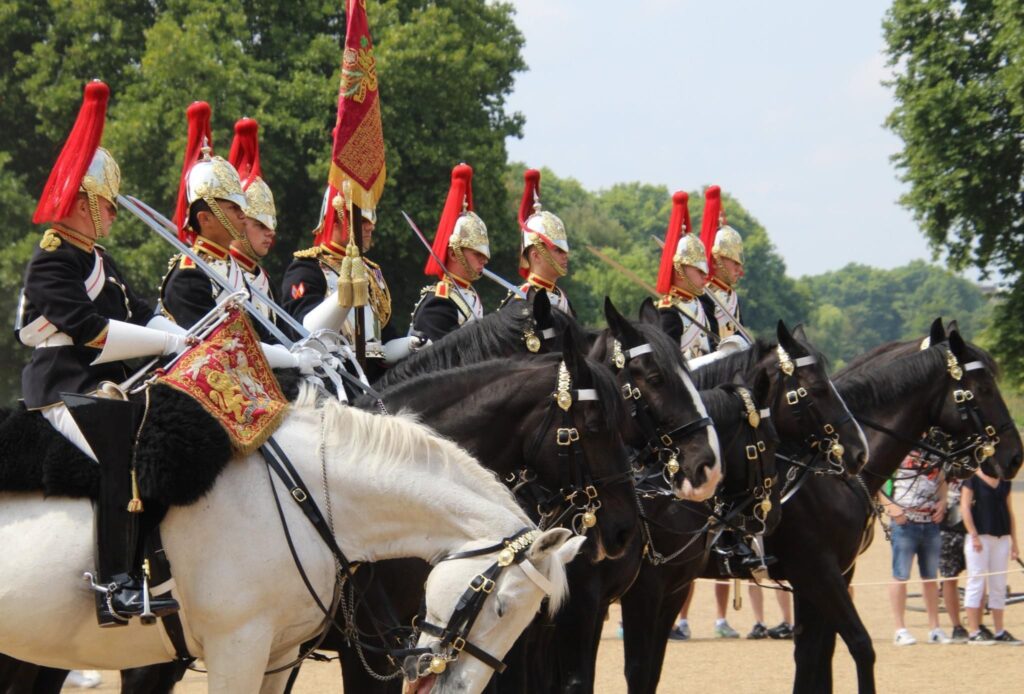
The Blues and Royals, one of the most prestigious regiments in the British Army, holds a distinguished place within the Household Cavalry. Known for their dual role in ceremonial duties and active military service, the Blues and Royals combine centuries-old traditions with modern military effectiveness.
Historical Background
The Blues and Royals were formed in 1969 by the amalgamation of two historic regiments: the Royal Horse Guards (The Blues) and the Royal Dragoons (The Royals). The Royal Horse Guards trace their lineage back to 1661, established by King Charles II, while the Royal Dragoons date back to 1661 as well. Both regiments have storied histories filled with participation in key military conflicts and ceremonial roles. The Royal Horse Guards earned their nickname “The Blues” due to their distinctive blue uniforms, while the Royal Dragoons, known for their red coats, were often referred to as “The Royals.”
Ceremonial Duties
The Blues and Royals are widely recognized for their ceremonial roles, a crucial aspect of their service within the Household Cavalry. They are one of the two regiments, alongside The Life Guards, responsible for state ceremonies and public duties that symbolize the continuity and dignity of the British monarchy. The most visible of these duties include the Changing of the Guard at Buckingham Palace, the daily Guard Mounting at Horse Guards Parade, and participation in the annual Trooping the Colour.
Their ceremonial attire is a striking feature that captures public imagination. The Blues and Royals wear dark blue tunics, polished metal cuirasses, and helmets adorned with red plumes. These uniforms, combined with their expertly trained black horses, present an image of discipline and splendor that is deeply ingrained in British culture.
Operational Role
Beyond their ceremonial functions, the Blues and Royals are fully operational soldiers trained for modern warfare. They form part of the Household Cavalry Regiment, an armored reconnaissance unit equipped with advanced vehicles and weaponry. This dual capability ensures that members of the Blues and Royals are highly adaptable, capable of switching from public ceremonial duties in London to active service in conflict zones worldwide.
In recent years, the Blues and Royals have been deployed in various international operations, demonstrating their versatility and professionalism. They have served in Northern Ireland during the Troubles, in the Balkans during the Yugoslav Wars, and more recently in Iraq and Afghanistan. These deployments highlight their role in modern military operations, including reconnaissance, peacekeeping, and combat missions.
Training and Recruitment
The rigorous training regimen for the Blues and Royals underscores the high standards expected of its soldiers. Recruits first undergo the standard 14-week British Army basic training before advancing to specialized training specific to the Household Cavalry. This includes mastering equestrian skills, ceremonial drill, and the technical aspects of armored reconnaissance. The training is designed to prepare soldiers for the diverse demands of their dual roles.
Recruitment into the Blues and Royals is competitive, with a focus on selecting individuals who demonstrate not only physical and mental fortitude but also a strong sense of duty and tradition. Historically, the regiment drew many of its members from the aristocracy, but today, it is open to all who meet its exacting standards, reflecting a broader and more inclusive approach.
Cultural Impact and Legacy
The Blues and Royals have made a significant cultural impact, embodying the connection between the military and the British monarchy. They are often present at major state events, including royal weddings, state funerals, and significant national celebrations, reinforcing their role in the ceremonial life of the nation. Their participation in these events underscores the continuity and pageantry that are hallmarks of British heritage.
One of the most notable members of the Blues and Royals is Prince Harry, who served with distinction, bringing modern recognition to the regiment’s storied history. His service included two tours in Afghanistan, where he earned respect for his commitment and bravery, further highlighting the regiment’s operational capabilities.
Conclusion
The Blues and Royals represent a unique blend of historical tradition and modern military excellence. From their origins in the 17th century to their current role in the British Army, they have maintained a standard of excellence that reflects their rich heritage and commitment to serving both the Crown and the country. Their dual role as ceremonial guardians and active soldiers makes them an integral part of Britain’s military and cultural landscape.